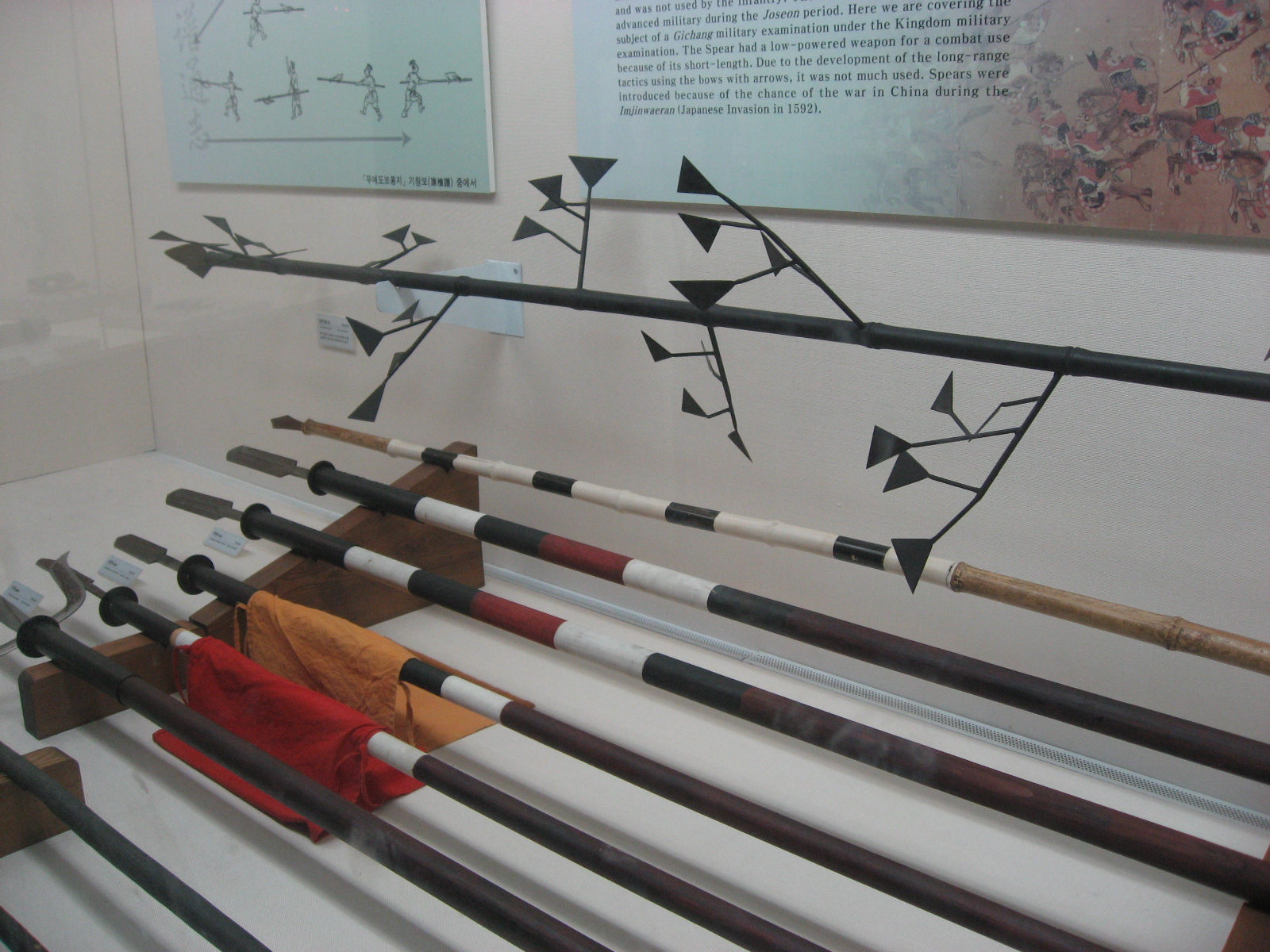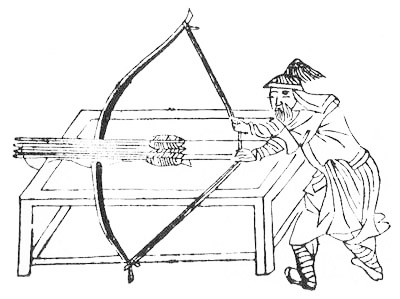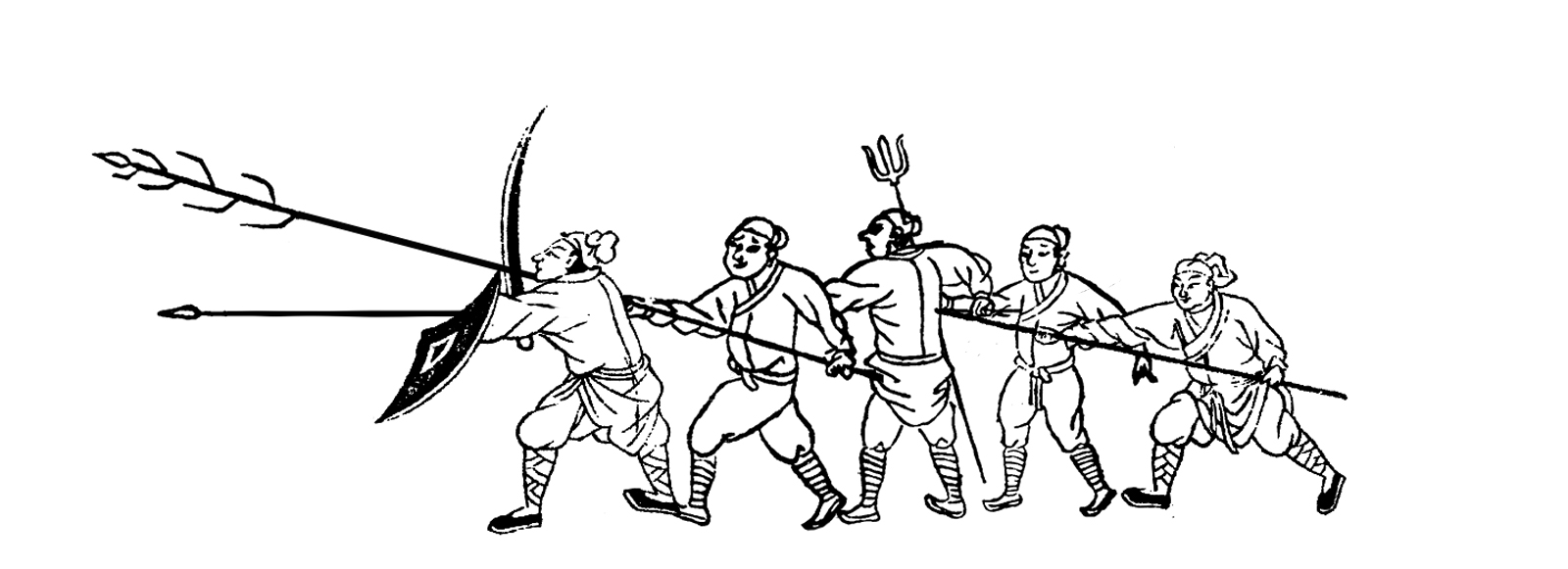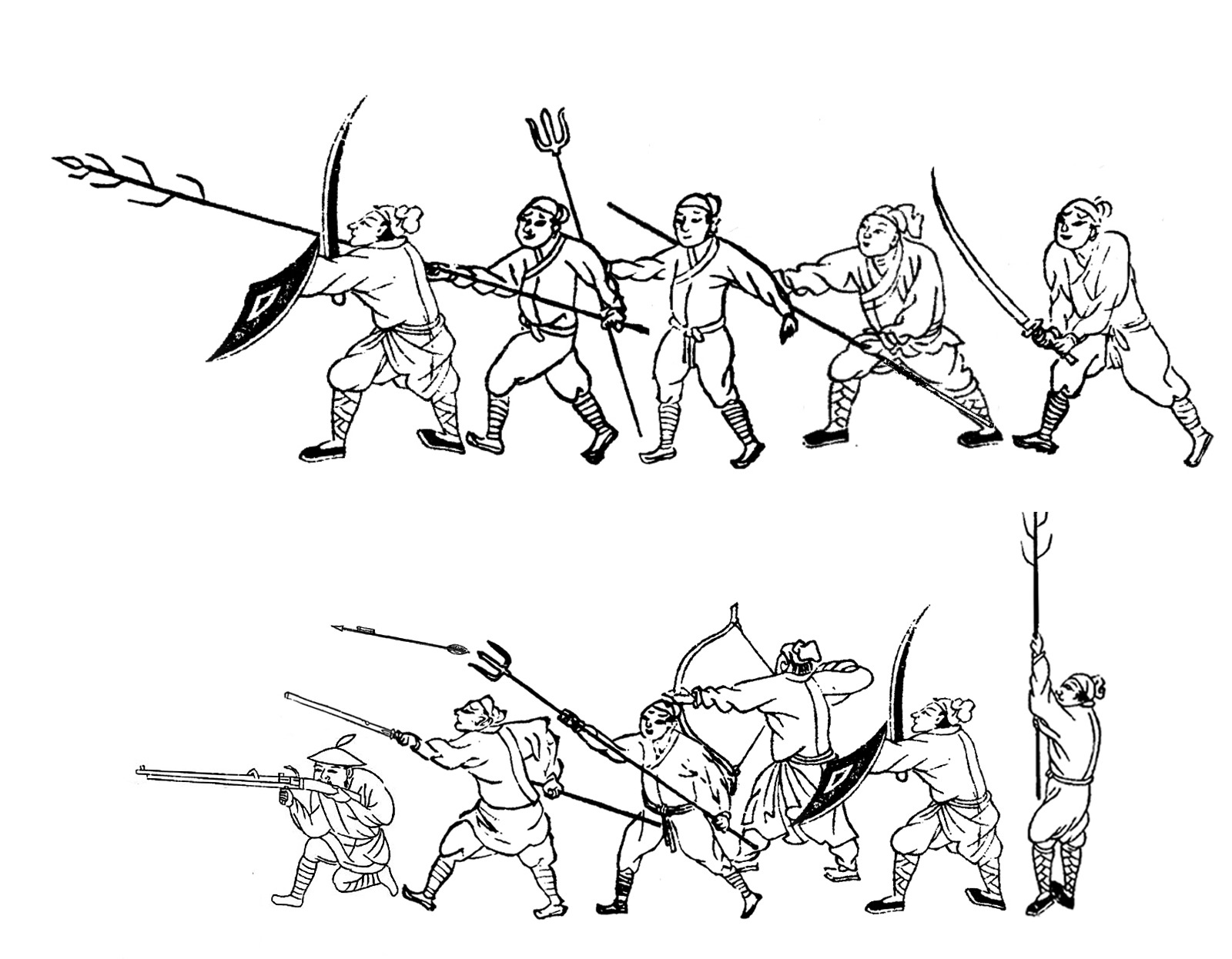|
Lang Xian
A lang xian, which can be translated as "wolf brush" or "wolf bamboo" or "multiple tipped bamboo spear" was a branched, multi-tipped spear with blades attached to the branches. The blades could be dipped in poison. The lang xian was a weapon well suited for defense, as it would be difficult for an opponent to assault the wielder without risking contact with the blades. It was probably an invention of the Chinese general Qi Jiguang of the Ming Dynasty, who described it in his manual titled ''Jixiao Xinshu''. The manual describes that the lang xian acted as backup for the rattan shield bearers in a "mandarin duck formation". In Korea, the weapon, known as ''nangseon'', was mentioned as early as the 16th century martial arts manual ''Muyejebo'', which was based on the ''Jixiao Xinshu''. A notable variant design is Xian Qiang (筅槍, lit. 'Brush spear'), which reduces the number of branches to four or five layers, sacrificing some defensive potential for increased maneuverability ... [...More Info...] [...Related Items...] OR: [Wikipedia] [Google] [Baidu] |
Wubei Zhi
The ''Wubei Zhi'' (; ''Treatise on Armament Technology'' or ''Records of Armaments and Military Provisions''), also commonly known by its Japanese translated name Bubishi, is a military book in Chinese history. It was compiled in 1621 by (茅元儀 ''Máo Yuányí''; 1594–1640?), an officer of waterborne troops in the Ming dynasty. The ''Wubei Zhi'' contains 240 volumes, 10,405 pages, and more than 200,000 Chinese characters. Structure ''Wubei Zhi'' consists of five sections, "Bing Jue Ping", "Zhan Lue Kao", "Zhen Lian Zhi", "Jun Zi Sheng", and "Zhan Du Zai". *"Bing Jue Ping" (Commentary on Military Formulae) Containing 18 chapters, this section includes military theories from significant figures including, but not limited to, Sun Tzu. Some of these theories date back to the last years of the Eastern Zhou dynasty, more than 1,800 years before the editor. *"Zhan Lue Kao" (Consideration of Tactics) This section consists of 31 chapters, and describes more than 600 specifi ... [...More Info...] [...Related Items...] OR: [Wikipedia] [Google] [Baidu] |
Spear
A spear is a polearm consisting of a shaft, usually of wood, with a pointed head. The head may be simply the sharpened end of the shaft itself, as is the case with Fire hardening, fire hardened spears, or it may be made of a more durable material fastened to the shaft, such as bone, flint, obsidian, copper, bronze, iron, or steel. The most common design for hunting and/or warfare, since modern times has incorporated a metal spearhead shaped like a triangle, lozenge (shape), diamond, or Glossary of leaf morphology, leaf. The heads of fishing spears usually feature multiple sharp Tine (structural), points, with or without barbs. Spears can be divided into two broad categories: those designed for thrusting as a melee weapon (including weapons such as lances and Pike (weapon), pikes) and those designed for throwing as a ranged weapon (usually referred to as javelins). The spear has been used throughout human history as a weapon for hunting and/or fishing and for warfare. Along with ... [...More Info...] [...Related Items...] OR: [Wikipedia] [Google] [Baidu] |
Qi Jiguang
Qi Jiguang (, November 12, 1528 – January 17, 1588), courtesy name Yuanjing, art names Nantang and Mengzhu, posthumous name Wuyi, was a Chinese military general and writer of the Ming dynasty. He is best known for leading the defense on the coastal regions against ''wokou'' pirate activities in the 16th century, as well as for the reinforcement of the Great Wall of China. Qi is also known for writing the military manuals '' Jixiao Xinshu'' and Lianbing Shiji or ''Record of Military Training'' (), which he based on his experience as a martial educator and defensive planner in the Ming military forces. He is regarded as a hero in Chinese culture. Biography Early life Qi Jiguang was born in the town of Luqiao in Shandong province to a family with a long military tradition. His forefather served as a military leader under the Hongwu Emperor and died in battle. When Zhu Yuanzhang became the founding emperor of the Ming dynasty, he bestowed upon the Qi family the hereditary p ... [...More Info...] [...Related Items...] OR: [Wikipedia] [Google] [Baidu] |
Ming Dynasty
The Ming dynasty, officially the Great Ming, was an Dynasties of China, imperial dynasty of China that ruled from 1368 to 1644, following the collapse of the Mongol Empire, Mongol-led Yuan dynasty. The Ming was the last imperial dynasty of China ruled by the Han people, the majority ethnic group in China. Although the primary capital of Beijing fell in 1644 to a rebellion led by Li Zicheng (who established the short-lived Shun dynasty), numerous rump state, rump regimes ruled by remnants of the House of Zhu, Ming imperial family, collectively called the Southern Ming, survived until 1662. The Ming dynasty's founder, the Hongwu Emperor (1368–1398), attempted to create a society of self-sufficient rural communities ordered in a rigid, immobile system that would guarantee and support a permanent class of soldiers for his dynasty: the empire's standing army exceeded one million troops and the naval history of China, navy's dockyards in Nanjing were the largest in the world. H ... [...More Info...] [...Related Items...] OR: [Wikipedia] [Google] [Baidu] |
Jixiao Xinshu
The ''Jixiao Xinshu'' () or ''New Treatise on Military Efficiency'' is a military manual written during the 1560s and 1580s by the Ming dynasty general Qi Jiguang. Its primary significance is in advocating for a combined arms approach to warfare using five types of infantry and two type of support. Qi Jiguang separated infantry into five separate categories: firearms, swordsmen, archers with fire arrows, ordinary archers, and spearmen. He split support crews into horse archers and artillery units. The ''Jixiao Xinshu'' is also one of the earliest-existing East Asian texts to address the relevance of Chinese martial arts with respect to military training and warfare. Several contemporary martial arts styles of Qi's era are mentioned in the book, including the staff method of the Shaolin temple. Background In the late 16th century the military of the Ming dynasty was in poor condition. As the Mongol forces of Altan Khan raided the northern frontier, China's coastline fell ... [...More Info...] [...Related Items...] OR: [Wikipedia] [Google] [Baidu] |
Rattan Shield
The rattan shield was used by the militaries of China and Korea since the Ming dynasty and the Joseon dynasty, respectively. The Ming general Qi Jiguang described its use in his book, the ''Jixiao Xinshu'', which was reproduced in the Korean ''Muyejebo'' that contains the first Korean account of the shield. The rattan shield is circular and often have a fierce tiger face on it, so it is also called the tiger shield. A similar native shield in the Philippines (and parts of Borneo) made from tightly-woven rattan or wood is known as ''taming''. Use The rattan shield originated in Southern China, seen as early as the Three Kingdoms period, carried by the jungle tribal warriors in the south of the Shu Kingdom, where it is hilly, wet, and forested and rattan can be found and grown. First rattan is harvested, then dipped in oil to harden to make armor and shields. The shields are light but durable, and in later ages where guns are used, the firearm projectile/shrapnel would get stuck ... [...More Info...] [...Related Items...] OR: [Wikipedia] [Google] [Baidu] |
Mandarin Duck Formation
The ''Jixiao Xinshu'' () or ''New Treatise on Military Efficiency'' is a military manual written during the 1560s and 1580s by the Ming dynasty general Qi Jiguang. Its primary significance is in advocating for a combined arms approach to warfare using five types of infantry and two type of support. Qi Jiguang separated infantry into five separate categories: firearms, swordsmen, archers with fire arrows, ordinary archers, and spearmen. He split support crews into horse archers and artillery units. The ''Jixiao Xinshu'' is also one of the earliest-existing East Asian texts to address the relevance of Chinese martial arts with respect to military training and warfare. Several contemporary martial arts styles of Qi's era are mentioned in the book, including the staff method of the Shaolin temple. Background In the late 16th century the military of the Ming dynasty was in poor condition. As the Mongol forces of Altan Khan raided the northern frontier, China's coastline fell ... [...More Info...] [...Related Items...] OR: [Wikipedia] [Google] [Baidu] |
Muyejebo
The '' Muyejebo'' (''Compendium of Several Martial Arts'') is the oldest extant Korean martial arts manual, compiled by Han Gyo (韓嶠) in 1598 during the reign of King Seonjo. With the addition of material from Japanese martial arts, a supplement, ''Sequel to the Book of Martial Arts'' (무예제보번역속집), compiled by Choi Ki-nam, was published in 1610. It was reprinted from woodblocks in 1714 and a surviving copy was designated as Tangible Cultural Heritage No. 437 on 14 February 2019. History As the Imjin War dragged on for years, Korea needed a way to effectively and efficiently train a large number of troops, and the Korean military adopted a training methodology based on a Ming dynasty Chinese military manual called the ''Jixiao Xinshu'' (Hangul: 기효신서, Hanja: 紀效新書), written by the famed Chinese general, Qi Jiguang (戚继光). The book was of particular interest to Koreans, as it was written by a Chinese commander who had successfully defeated a ... [...More Info...] [...Related Items...] OR: [Wikipedia] [Google] [Baidu] |
Xian Qiang
Xi'an is the capital of the Chinese province of Shaanxi. A sub-provincial city on the Guanzhong plain, the city is the third-most populous city in Western China after Chongqing and Chengdu, as well as the most populous city in Northwestern China. Its total population was 12.95 million as of the 2020 census, including an urban population of 9.28 million. Known as Chang'an throughout much of its history, Xi'an is one of China's Four Great Ancient Capitals, having held the position under several of the most important dynasties in Chinese history, including the Western Zhou, Qin, Western Han, Sui, Northern Zhou and Tang. Xi'an is now the second-most popular tourist destination in China. The city was one of the terminal points on the Silk Road during the ancient and medieval eras, as well as the home of the 3rd-century BC Terracotta Army commissioned by Emperor Qin Shi Huang—both of which are listed as World Heritage Sites by UNESCO. Since the 1980s, as part of ... [...More Info...] [...Related Items...] OR: [Wikipedia] [Google] [Baidu] |









